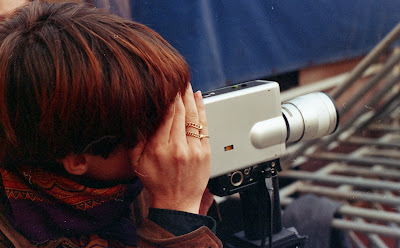“If you can work without any system of regulation or control, then you can increasingly utilize and develop a fresh mode of cinema.”
Masao Adachi
 During six days ten participants coming from different
professional backgrounds will learn how to operate super 8 cameras and hand
process their own color reversal films. The Workshop is hosted by Beirut Art Center during the exhibition NOW HERE THEN ELSEWHERE by Eric Baudelaire. Film Processing will take place
in Mansion where the Laboratory is installed.
During six days ten participants coming from different
professional backgrounds will learn how to operate super 8 cameras and hand
process their own color reversal films. The Workshop is hosted by Beirut Art Center during the exhibition NOW HERE THEN ELSEWHERE by Eric Baudelaire. Film Processing will take place
in Mansion where the Laboratory is installed.  The theme of the Color Club Workshop
is “Fukeiron” – the cinema of landscape – which is a political element in the
cinema of Masao Adachi, a Japanese filmmaker and scriptwriter who was most
active in the 60’s and the 70’s. Together with Eric Baudelaire, during the
workshop we will screen films of Adachi and discuss his cinematographic
philosophy and his belief in the non-existent difference between revolution and
cinema. Eric Baudelaire is the director of the film Anabasis, which is based on the cinema of Masao Adachi and his
“Fukeiron” technique, which holds that by filming a landscape you frame the
political and social history of a place through its physical evolution.
The theme of the Color Club Workshop
is “Fukeiron” – the cinema of landscape – which is a political element in the
cinema of Masao Adachi, a Japanese filmmaker and scriptwriter who was most
active in the 60’s and the 70’s. Together with Eric Baudelaire, during the
workshop we will screen films of Adachi and discuss his cinematographic
philosophy and his belief in the non-existent difference between revolution and
cinema. Eric Baudelaire is the director of the film Anabasis, which is based on the cinema of Masao Adachi and his
“Fukeiron” technique, which holds that by filming a landscape you frame the
political and social history of a place through its physical evolution.  The participants will conceive of a synopsis for a film that they would like to
shoot during the workshop, adapting the cinema of landscape and anticipating
the final edit of their film during their filming. This is a technique that is
used as an exercise for the filmmaker to think his film before shooting and so
that he shoots the scenes in the right order.
The participants will conceive of a synopsis for a film that they would like to
shoot during the workshop, adapting the cinema of landscape and anticipating
the final edit of their film during their filming. This is a technique that is
used as an exercise for the filmmaker to think his film before shooting and so
that he shoots the scenes in the right order. Super 8 film cartridges are 3 minutes long at 24 frames per second, so at the end of the workshop we aim to have 10 films of 3 minutes each. Participants are allowed to use up to two cartridges depending on the nature of their film and are allowed to potentially work together. All the films produced during this workshop have to be shot, processed and ready to screen before the sixth day where the participants will host a public screening in Beirut Art Center’s auditorium.
 Masao Adachi (born May 13, 1939 in Fukuoka Prefecture)
is a Japanese screenwriter and director, most active in the 1960s and 70s. Best
known for his writing collaborations with directors Kōji Wakamatsu and Nagisa
Oshima, he also directed a number of his own films, usually dealing with
left-wing political themes. He stopped making films in the early 1970s and
joined the Japanese Red Army, an armed militant organization. After living in
Lebanon for 28 years, he was arrested for passport violations, and was found in
September 2001, receiving a four-year sentence suspended to 18 months. After
his release he was deported to Japan via Jordan, where he was re-arrested on
other passport violations. After being
Masao Adachi (born May 13, 1939 in Fukuoka Prefecture)
is a Japanese screenwriter and director, most active in the 1960s and 70s. Best
known for his writing collaborations with directors Kōji Wakamatsu and Nagisa
Oshima, he also directed a number of his own films, usually dealing with
left-wing political themes. He stopped making films in the early 1970s and
joined the Japanese Red Army, an armed militant organization. After living in
Lebanon for 28 years, he was arrested for passport violations, and was found in
September 2001, receiving a four-year sentence suspended to 18 months. After
his release he was deported to Japan via Jordan, where he was re-arrested on
other passport violations. After being held for a year-and-a-half he was convicted and released based on the time he had already served. Since his release, he has resumed making films after a 30-year absence.











